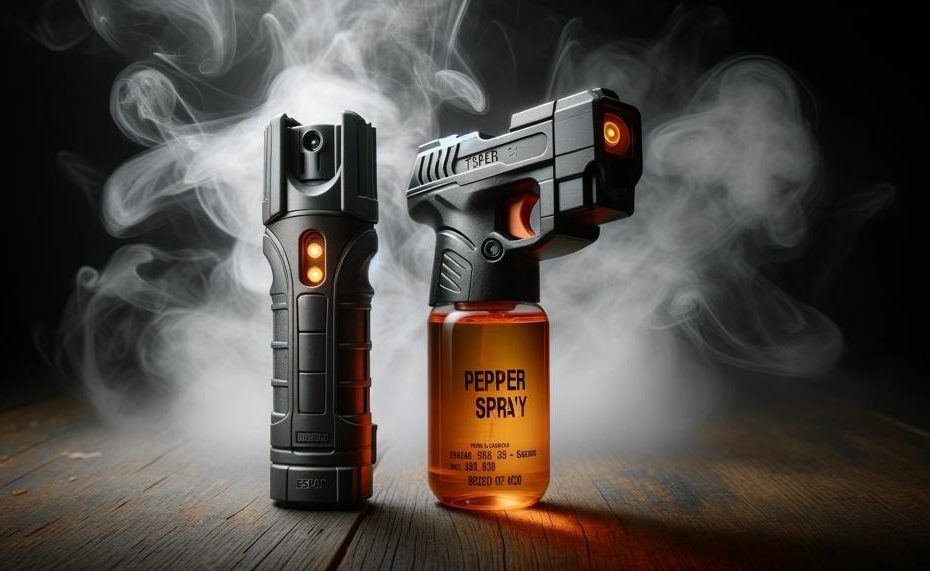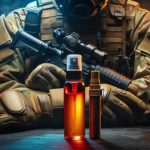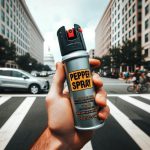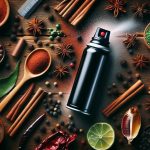Pepper spray and tasers – two tools that have become increasingly popular for self-defense in recent years. While they both aim to immobilize an attacker, they use different methods and have varying levels of effectiveness. In this blog post, we will compare pepper spray and tasers to help you determine which one may be the better option for your personal safety needs.
Here are some important points to keep in mind as we explore this topic:
- Pepper spray contains a chemical irritant that causes temporary blindness, difficulty breathing, and excruciating burning pain upon contact.
- Tasers deliver electric shock to disrupt the body’s neuromuscular system, resulting in temporary paralysis and loss of muscle control.
- Both pepper spray and tasers can effectively fend off multiple attackers or those under the influence of drugs or alcohol.
- Tasers have a longer range than pepper spray, making them useful for situations where an attacker is at a distance.
- Pepper spray is more accessible and affordable than tasers, making it a popular choice for everyday carry.
- The legality of both pepper spray and tasers varies by state and country, so it’s crucial to check local laws before purchasing or carrying either tool.
Now that we have an overview of what pepper spray and tasers are, let’s dive deeper into their differences and similarities to help you make an informed decision on which one may be right for you.
Contents
Pepper Spray or Taser: Which One Should You Choose?
When it comes to self-defense, pepper spray and tasers are two popular options. While both can effectively protect you from potential attackers, there are key differences between the two that you should consider before making a decision.
| Pepper Spray | Taser |
| Derived from chili plants, pepper spray has been known to cause temporary blindness and severe discomfort when sprayed on someone’s face. | A taser, on the other hand, delivers an electric shock that causes muscle contractions and immobilizes the attacker. |
| Pepper spray requires refilling or replacement cartridges, which can be an additional cost. On the other hand, tasers are rechargeable and have a longer lifetime. | Tasers tend to have a higher price point, ranging from $350 to over $1000, while pepper spray can be purchased for as low as $15. |
| One advantage of pepper spray is its longer range and immediate effect upon contact. However, tasers may have a shorter range but their effects can last anywhere from 5 to 60 minutes. | Additionally, pepper spray mainly affects the respiratory system and can be influenced by wind, while tasers target the central nervous system and are immune to wind interference. |
| While pepper spray may cause severe discomfort for 30 minutes or more, it does not pose a risk of fatality. On the other hand, tasers have the potential to be fatal but do not have any long-term physical harm once their effects wear off. | In terms of usage restrictions, pepper spray tends to be less restricted and easier to conceal compared to tasers. However, some states heavily regulate the possession and usage of tasers, and may even require a permit. |
| Both pepper spray and tasers have built-in safety features to prevent accidental discharge or being used against the user. However, tasers may require additional training for proper usage. |
Deciding Factors:
- Personal preference: Ultimately, the weapon you choose should be one that you feel comfortable using and can handle effectively in a high-stress situation.
- Budget: Consider the cost of both options, as well as any additional expenses such as refills or training.
- Usage restrictions: It is important to check your state’s laws and regulations regarding the use and possession of pepper spray and tasers.
- Effectiveness: Evaluate the range, stopping power, and immediate effects of both weapons to determine which would be more effective for your personal needs.
- Maintenance: Consider whether the convenience of a rechargeable taser outweighs the need for refilling or replacing pepper spray cartridges.
How Pepper Spray and Tasers Differ
When it comes to self-defense, choosing between pepper spray and tasers can be a tough decision. Both have their unique strengths and weaknesses that should be carefully considered before making a choice.
Effectiveness:
Pepper spray has a longer range than tasers, which typically extends up to 10 feet. This means you can use it from a safe distance, minimizing the risk of harm to yourself. On the other hand, tasers require you to be in close proximity to your attacker, typically within 7-10 feet. However, due to the electric shock they deliver, they have a higher success rate in incapacitating attackers.
Pepper spray is known for its effectiveness in causing temporary blindness, difficulty breathing, and intense burning sensations on the skin. These effects can give you enough time to escape or call for help. Tasers, on the other hand, can cause severe pain, muscle contractions, and temporary paralysis. In rare cases, they can even lead to cardiac arrest.
Usage:
Pepper spray is legal to carry in most states without any special permits. However, some states may have restrictions on the size and strength of pepper spray that can be carried. On the other hand, tasers may require a permit or license to carry and use in certain states. Some states also have limitations on the type and strength of tasers that can be used.
Pepper spray is relatively easy to use, requiring you to simply aim and spray at your attacker’s face. However, tasers may require more training and practice to effectively aim and use.
Safety:
In terms of safety, pepper spray is generally considered safe with no risk of fatality. However, it can cause temporary discomfort and irritation. Tasers, on the other hand, have a potential risk of causing cardiac arrest and death in rare cases. They should not be used on individuals with heart conditions or pacemakers.
It’s important to note that both pepper spray and tasers can potentially harm bystanders if used improperly or in close quarters. It’s crucial to carefully aim and consider the surroundings before using either option in crowded areas.
Benefits of Pepper Spray
Pepper spray has numerous advantages over tasers when it comes to self-defense. These include a longer range, affordability, and simplicity of use. Compared to tasers, pepper spray can be sprayed from a distance of 8-12 feet, providing a safer distance from the attacker. This is especially beneficial for individuals who may not have the strength or agility to engage in close combat.
In terms of cost, pepper spray is relatively inexpensive compared to tasers, making it a more accessible option for those on a budget. Its ease of use and minimal training required also make it a practical choice for individuals who may not have experience with self-defense techniques.
| Pepper Spray | Taser | |
| Range | 8-12 feet | 15-20 feet |
| Affordability | Relatively inexpensive | More expensive |
| Simplicity of Use | Easy to use and minimal training required | May require more training and skill to use effectively |
Moreover, pepper spray also has other benefits that make it a popular choice for self-defense. One of these is its immediate effects when used correctly. It causes intense burning sensation, difficulty breathing, and temporary blindness, giving the user enough time to escape or seek help.
Unlike tasers, pepper spray is less affected by external factors such as wind or rain, making it a more reliable option in various situations. And in terms of legal restrictions, pepper spray is legal in most states and countries, making it easily accessible compared to tasers, which may have stricter regulations.
Drawbacks of Pepper Spray
As with any self-defense tool, pepper spray has its drawbacks, and it’s vital to understand them before using it.
One significant factor to consider is an individual’s response to pepper spray. While it can cause intense pain and temporary blindness in most people, it may not have the same effect on individuals under the influence of drugs or alcohol. This could potentially leave the user vulnerable and unable to defend themselves effectively.
Another drawback is the difficulty of deploying pepper spray in high-stress and violent situations. In these scenarios, close proximity to the attacker is necessary, making it challenging to use without putting oneself in danger. Additionally, in real-life situations such as crowded areas or enclosed spaces, pepper spray may not be practical to use due to the risk of affecting innocent bystanders.
Misuse is another concern when it comes to pepper spray. It’s essential to use it responsibly and only when necessary. Using it on someone who is not a threat can lead to severe harm and legal consequences. It’s crucial to understand the laws and regulations surrounding pepper spray in your state before using it.
Furthermore, weather conditions can also affect the use of pepper spray. In windy or rainy conditions, there is a higher chance of the spray blowing back onto the user, causing discomfort and temporary blindness. This highlights the importance of considering all factors before deploying pepper spray.
In rare cases, chemical sprays have caused death, particularly in individuals with pre-existing respiratory issues. While these instances are uncommon, it’s crucial to be aware of them and use pepper spray with caution.
Finally, it’s essential to note that pepper spray may be illegal in certain states and cannot be carried onto airplanes or into specific buildings. It’s crucial to research and understand the laws surrounding its use in your state before purchasing or carrying it for self-defense purposes.
Benefits of Tasers
One of the most significant advantages of tasers is that they do not require physical contact. This means that you can defend yourself without getting too close to your attacker, reducing the risk of harm to yourself. Pepper spray, on the other hand, requires you to be close enough to your attacker to spray them, putting you in potential danger.
Moreover, tasers have a much stronger effect compared to pepper spray. Once deployed, tasers cause muscle contractions and can incapacitate an attacker for several minutes. In comparison, pepper spray only causes temporary discomfort and does not guarantee an attacker’s incapacitation.
Another benefit of tasers is that they can be used multiple times. This gives you more chances to defend yourself if your first attempt is unsuccessful. In contrast, pepper spray typically has a limited number of uses before needing replacement.
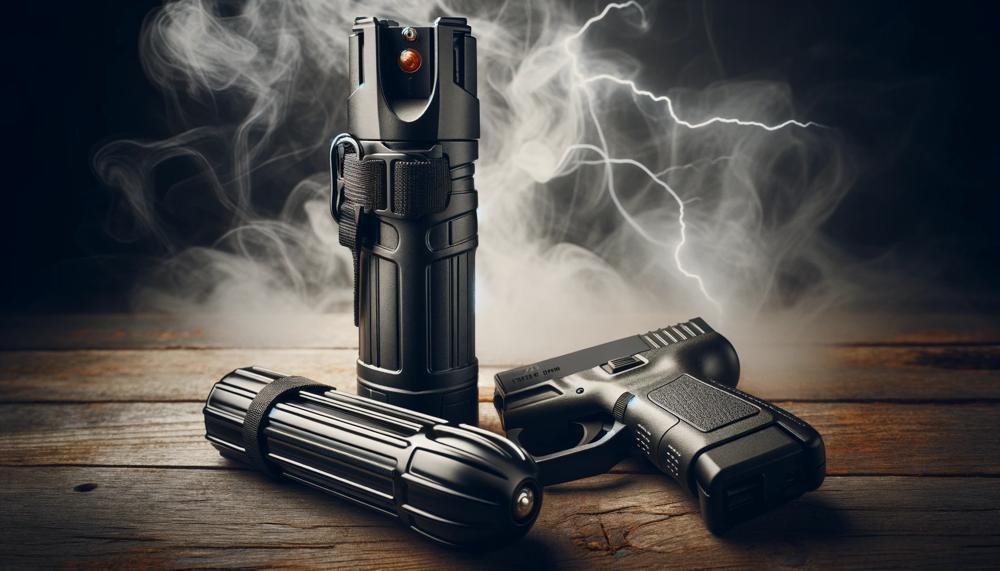
Using a taser is also easier than using pepper spray. With pepper spray, you must aim and spray accurately, which can be difficult in a high-stress situation. Tasers only require you to aim in the general direction of your attacker and press a button.
Tasers are also effective against multiple attackers, making it a practical choice for self-defense in dangerous situations. Additionally, it has fewer legal consequences compared to using pepper spray in some areas.
Finally, tasers have a longer range compared to pepper spray, allowing you to protect yourself from a distance. This is especially beneficial if you are trying to defend yourself from someone who is armed or larger than you.
Drawbacks of Tasers
When considering tasers as a self-defense tool, it’s essential to acknowledge their drawbacks. These include potential health risks, misuse by law enforcement, legal consequences, and the possibility of ineffectiveness against certain individuals.
| Health Risks | Tasers have been connected to various health risks, such as cardiac arrest, seizures, and respiratory failure. These risks are even more significant when used on individuals with pre-existing medical conditions or who are under the influence of drugs or alcohol. |
| Misuse by Law Enforcement | There have been instances where tasers have been misused by law enforcement, resulting in injury and even death. This has raised concerns about the training and protocols in place for appropriate taser usage by law enforcement officers. |
| Legal Consequences | While tasers may have lower legal consequences compared to other weapons, there is still a possibility of facing legal action if they are used improperly. This includes using them on individuals who do not pose a threat or using them for purposes other than self-defense. |
| Ineffectiveness Against Certain Individuals | Tasers may not be effective against individuals who are under the influence of certain drugs or have a high tolerance for pain. In these cases, tasers may not incapacitate the individual as intended, leaving the user vulnerable to an attack. |
It’s worth noting that these drawbacks can also apply to other self-defense weapons, such as pepper spray. However, tasers have gained more attention due to their use by law enforcement and their controversial effects on individuals.
For Self-Defense, Pepper Sprays Are Better Than Tasers
For self-defense purposes, pepper sprays are considered to be a superior choice over tasers due to their ease of use, affordability, and less restrictive laws surrounding their usage. Moreover, pepper spray offers a safe distance between the user and the attacker, making it a more effective tool in dangerous situations.
Let’s delve deeper into the advantages of choosing pepper spray over a taser.
| Advantage | Pepper Spray | Taser |
| Ease of Use | Pepper spray can be used from a distance, providing the user with an advantage against the attacker, without having to physically confront them. | To use a taser effectively, one must have close proximity to the attacker, which can be challenging for individuals who may not possess physical strength. |
| Cost | Pepper spray is significantly cheaper than tasers, with prices starting from $10-$50 compared to several hundred dollars for a taser. | The cost of tasers can be prohibitively expensive for some individuals, making pepper spray a more accessible option. |
| Legality | Laws governing the use of pepper spray are generally less restrictive than those for tasers, making it more accessible and easier to purchase. | Tasers are heavily regulated and may require permits or training before being purchased. |
| Safety Features | Modern pepper sprays come equipped with safety features such as locking mechanisms or dye markers to prevent accidental harm to the user. | Tasers require proper training for safe usage and have a higher risk of unintentional harm to the user. |
| Range | Pepper spray has a range of 10-12 feet, providing distance between the user and attacker, making it a safer option for self-defense. | Tasers may not be as effective on individuals under the influence of drugs or alcohol, making pepper spray a better option in these situations. |
| Temporary Incapacitation | Both pepper spray and tasers are designed to temporarily incapacitate an attacker without causing permanent harm. |
Ultimately, pepper spray is a more practical and safer choice for self-defense compared to tasers. Its ease of use, affordability, accessibility, safety features, and effectiveness make it the preferred option for many individuals looking to protect themselves.
Conclusion
In summary, the debate between pepper spray and tasers as self-defense tools is a complex one.
Both have their own unique advantages and disadvantages that must be carefully weighed before making a decision. While pepper spray offers a longer range and immediate effects, tasers have a higher success rate in incapacitating attackers.
Personal preference, budget, usage restrictions, effectiveness, and maintenance are all important factors to consider when choosing between the two. It is also crucial to research and understand the regulations and potential risks involved with using either option.
Whether you opt for pepper spray or a taser as your go-to self-defense tool, always use it responsibly and within legal boundaries.
